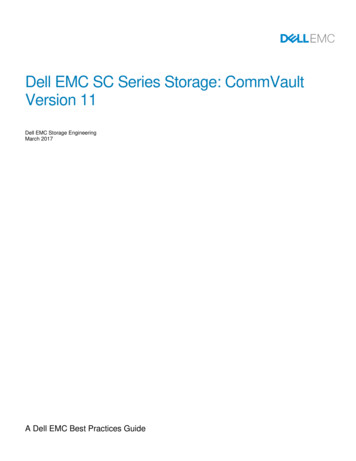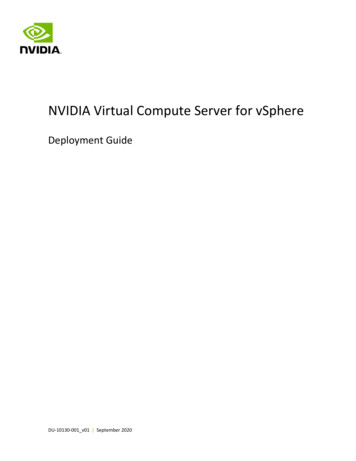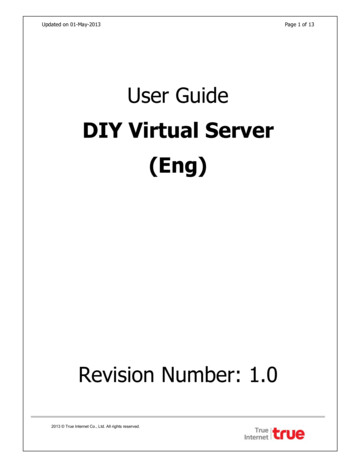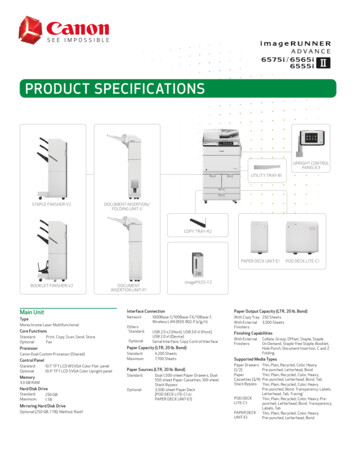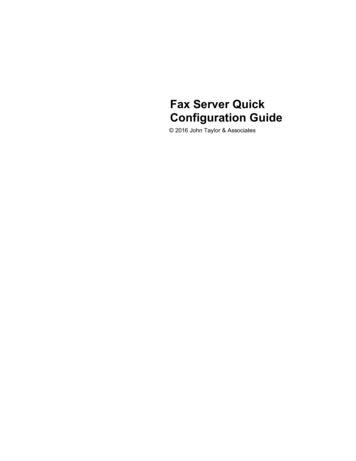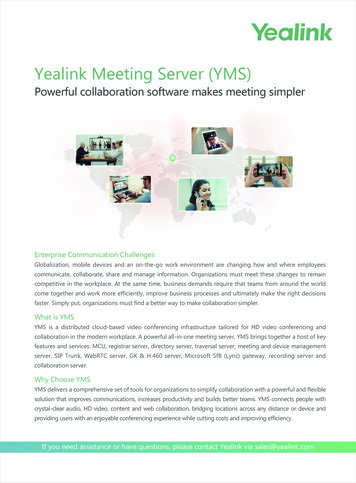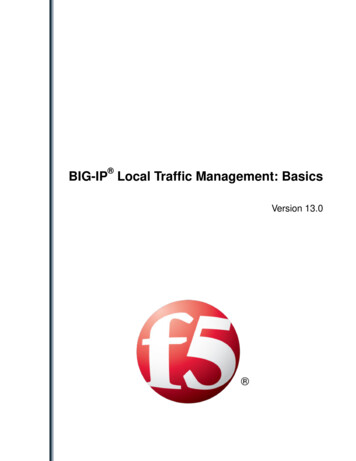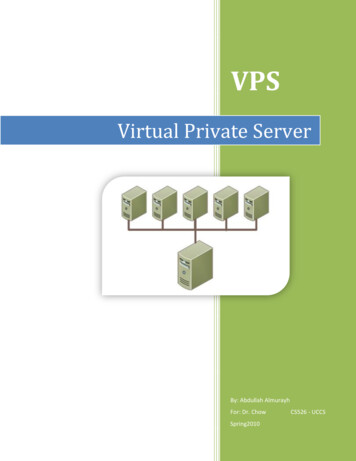
Transcription
VPSVirtual Private ServerBy: Abdullah AlmurayhFor: Dr. ChowSpring2010CS526 - UCCS
VPSUCCS – CS526 –Spring 2010ContentsSubjectP a g e 1Page1. Introduction22. VPS Technicality44. VPS architecture75. VPS Performance116. VPS Features167. Hosting Automation218. VPS enhancement229. Conclusion2610. References27
VPSUCCS – CS526 –Spring 20101. Introduction:A Web server is a high quality computer frame that delivers or serves content,information, and other resources that can be gathered through services. One goal ofhaving web servers is to provide Web hosting services that allows individuals andorganizations to make their own website accessible via the World Wide Web. Typically,web hosts are companies that provide space on a server they own or lease for use by theirclients, as well as providing Internet connectivity; which is called a data center. Someindividuals and organizations, for example, have universities with their own web serversand hosting services. However, there are two kinds of web hosting, shared and unshared.Shared web hosting is where many websites reside on one web server connected to theInternet. Each site resides on its own partition, or section/place on the server to keep itseparate from other sites. Those sites share the web server resources, such as CPU,memory, storage, IPs, connection, and the like. This is generally the most economicaloption for hosting, as many people share the overall cost of server maintenance.Information resources, in other words, have been revaluated and become incapable to betransferred across the internet. As a result, the performance was inconvenient eventhough the internet connection had gotten faster. Therefore, companies starteddistributing their web servers around the world, which is the which is basically thetechnique of distribution systems. Recently, there have been distributed physical serversglobally in many countries that belong to one company dedicated to serve as fast aspossible. According to Akami, which is a leading company in web hosting services, statesthat “Akamai has created a digital operating environment for the Web. Our globalplatform of thousands of specially-equipped servers helps the Internet withstand thecrush of daily requests for rich, dynamic, and interactive content, transactions, andapplications. When delivering on these requests, Akamai detects and avoids Internetproblem spots and vulnerabilities, to ensure Websites perform optimally, media andsoftware download flawlessly, and applications perform reliably. [1]”.On top of that, some individuals and organizations started demanding independency.That means they wanted to have their own web server with no sharing, especially thosewho had a lot of content and information rather than popularity. This idea gives them theability to setup convenient resources for them. The resources all elements that areinvolved in a web server for both hardware (such as the processor, memory, storages andthe like), and software (such as operating systems, applications, bandwidth, root accessand more. This idea could be very smart, but this technique is expensive and difficult aswell. It is needed to be working even it costs a lot since it needs a lot of hardware,software, cool, power, and maintenance. Not only does that cost, but also the distributionsystem would significantly cost for setting up physical web servers everywhere. Thesedistributed servers need data centers at every distribution system location. The smartideal scheme that many hosting companies are getting isbased on virtualization.P a g e 2
VPSUCCS – CS526 –Spring 2010Virtualization can be defined as the approach that refers to the abstraction of computerresources by having software act as the actual hardware. Based on that, we began to seethe term of virtual computers; Virtual machines (VMs) are unreal computers no matterwhich class they are. Basically, they run and execute applications like real physicalmachines. According to Wikipedia definition of a virtual machine, it is said that “virtualmachine was originally defined by Popek and Goldberg as "an efficient, isolatedduplicate of a real machine". Current use includes virtual machines which have no directcorrespondence to any real hardware. [2]”In this paper, we are going to focus on virtualization based web servers. They are widelyused and strongly based on virtualization which have contributed to great businesssuccess.P a g e 3
VPSUCCS – CS526 –Spring 20102. VPS TechnicalityVPS stands for virtual private server which definitely means having the independency ofmanaging the entire resource of the server with no partner. It is virtually administered.The management aspect means a customer has total and absolute control of the privateserver and is able to do whatever he or she wants to do. It differs from shared server thatyou have to follow what the server consists of and what recourses it contains rather thanthe settings that may not be convenient for some customers’ applications, or does nothave the functional ability to run their programs. According to Scott, the SystemAdministrator of Eukhost hosting company, says that “SHARED HOSTING is like livingin an apartment building and sharing your neighbours' problems. You hear their musicthrough the wall. If one of them leaves the main door open, your security is at risk. On ashared server, all the website hostings share the operating system and resources.Problems with your neighbours' website hostings can slow down the server performanceor require it to be shut down while the problem is being fixed. The slowdowns may alsoresulted from having too many website hostings on a server. Your site's security dependsin part on decisions made by your web host and, perhaps, your neighbors too.[3]”he adds that “VPS Hosting HOSTING is more like living in a townhouse with your ownprivate yard, and without ever hearing your neighbors. The only common area you shareis the parking area and entrance; all traffic goes through one network port. In contrast toapartments or shared hosting accounts, you pay more for a VPS Hosting, but you can dowhat you want with the space, and your neighbors' problems aren't your problems.[3]”Based on the reasons stated above, many customers like to have their privacy with lesscost, but that cannot happen with the high cost of hardware and maintenance. However,nothing is impossible in that there is always a way that customers can have their privateservers take advantage of virtualization techniques. At this point, we can use VPS as thebest solution to provide independent servers with not much cost. In addition, byP a g e 4
VPSUCCS – CS526 –Spring 2010providing the reliability and the flexibility to VPS, they can be trusted and used in mosttypes of businesses.The VPS scheme works basically by having many kinds of virtual web servers on top ofan actual or physical web server. VPS share only a certain amount of the physical webserver resources. Each VPS is given a specific feature for each resource that it can use.As a result, other busy or overloaded VPS web servers cannot affect their neighbor webservers. This property is considered the most significant feature of VPS efficiency. Thisparticular VPS feature is different from reseller techniques. To define reseller hosting is ahosting technique where an account owner has the ability to use his or her allotted harddrive space and bandwidth to host websites. The reseller purchases the host's serviceswholesale and then sells them to customers for a profit. A certain portion of hard driveand bandwidth is allocated to the reseller account. The reseller may rent a dedicatedserver from a hosting company or resell shared hosting services. The reseller account issimply given the permission to sell a certain amount of disk space and bandwidth to hisown customers without renting a server from the web hosting company. However, this isa great difference from VPS since VPS has the root access and strict resources utilizationcapability, . Any busy website can affect other websites and resellers since all of themshare the same expanded amount of resources.Virtualization systems give each VPS a fixed amount of resources consumables. VPSservers can only consume what they are given. When a VPS server is being overloaded, itis only the overloaded server and may go down without damaging the other VPS serversthat are sharing the same physical server. When a machine runs, a virtualization softwarehas the operating system of the VPS run as it is actually running on top of physicalhardware.The amazing thing in virtualization systems is that most operating system can be run nomatter which physical hardware a web server has. Another interesting thing is thatwhenever the setting of hardware needs to be changed or expanded, it can be done viavirtualization systems which have the ability to change, copy, back up, and modify VPSservers.VPS web page on Wikipedia says “Virtual private servers bridge the gap between sharedweb hosting services and dedicated hosting services, giving independence from othercustomers of the VPS service in software terms but at less cost than a physical dedicatedserver. As a VPS runs its own copy of its operating system, customers have super userlevel access to that operating system instance, and can install almost any software thatruns on the OS. Certain software does not run well in a virtualized environment,including firewalls, anti-virus clients, and indeed virtualizers themselves; some VPSproviders place further restrictions, but they are generally lax compared to those inshared hosting environments. Due to the number of virtualization clients typicallyrunning on a single machine, a VPS generally has limited processor time, RAM, and diskspace. [4]”P a g e 5
VPSUCCS – CS526 –Spring 2010A VPS lies in-between shared web hosting and dedicated hosting in the spectrum of bothcontrol and power. A VPS system is a self-contained dedicated server which lives on aserver with other VPS systems. As stated previously VPS systems are also known asvirtual dedicated systems because they give the control of a full dedicated server but arehoused on a real physical server with other VPS systems. You get a good deal offlexibility with a VPS system since you gain the control, performance isolation andflexibility of a dedicated server while only having to pay for a portion of the server itself.[6]P a g e 6
VPSUCCS – CS526 –Spring 20103. VPS architectureVPS architecture is based on Operating System virtualization that provides the mosteffective use of hardware, software, and server resources. Each VPS performs exactlylike a stand-alone server. VPS's can be rebooted independently, as well as, haveindependent virtual objects such as root, users, IP addresses, processors, applications,settings, and files and folders.In fact, there are at least three prime elements for VPS architecture: Operating system-level virtualizationNetworking VirtualizationResource Management3.1. Operating system-level virtualizationOperating system-level virtualization is defined as a server virtualization method thatinstead of just having one server, the kernel allows multiple isolated instances to runat the same time and use the same operating system hardware. Virtual machines orservers work as if they are real servers and may even look and feel like a real serverto the owners or roots. In addition to isolation mechanisms, the kernel often providesresource management features to limit the impact of one container's activities to theother containers.OS virtualization is widely used in virtual hosting environments. Wikipedia statesthat “it is useful for securely allocating finite hardware resources amongst a largenumber of mutually-distrusting users. It is also used, to a lesser extent, forconsolidating server hardware by moving services on separate hosts into containerson the one server. Other typical scenarios include separating several applications toseparate containers for improved security, hardware independence, and addedresource management features. OS virtualization implementations that are capableof live migration can be used for dynamic load balancing of containers betweennodes in a cluster. [4] “P a g e 7
VPSUCCS – CS526 –Spring 2010For a VPS environment, OS virtualization gives each VPS the opportunity to act asis an independent system. This independency is provided by a virtualization layer inthe kernel of the host operating system. This layer is built between the physicaloperating system and the virtual instance. At this moment, a question may beconsidered asking “how much virtualization consumes CPU resources?” Parallelscompany, the most popular producer of OS virtualization, states that “Note thatonly a negligible part of the CPU resources is spent on virtualization (around 12%).[6]”Virtualization layers play the main role implemented in OS virtualization. It makesany VPS system perform exactly like a regular system. It adapts to make the VPSinstall, boot, process, run programs, communicate with others, and do so with nomodifications or adjustment. In addition, any Virtual Private Server root can changeany configuration file and install additional software. By using this layer, VirtualPrivate Servers are completely isolated from each other and no one can cause harmto the others. However, Virtual Private Servers are not bound to only one CPU, butcan use all available CPUs since processing can be scheduled to all available CPUs.An important thing that the virtualization layer does is that it constructs separatelyisolated containers on a single physical server with an OS instance to utilizehardware, software, data center and management efforts with maximum efficiency.The containers can be resembled as a machine, but done so virtually.Another element that is considered to be a link between virtualized OS and real OSis Hypervisor Virtualization. Hypervisor Virtualization according to Parallels, “has abase layer (usually a thin Linux kernel shown here as a hypervisor or standard OS)that is loaded directly on the bare server. To allocate hardware and resources to thevirtual machines (VMs), all hardware on the server must be virtualized. The nextlayer up shows each chip, board, etc. that must be virtualized so that it can beassigned to the VMs. Once in the VM itself, there is a complete copy of an operatingsystem and finally the application or workload. [6]”P a g e 8
VPSUCCS – CS526 –Spring 20103.2 Networking VirtualizationNetworks and communications are considered the relevant environment that VPSservers are made for. Because of having virtual machines that work as if they are realmachines, we need to consider that virtualized networking entities must be built upto make VPS servers communicate through virtual networks and nodes. In thisparticular element we can virtualize the main tools of networking such as, networkinterface card (NIC), routers, gateways, directors and the like. These virtualizedentities can act based on actual and physical networking entities such as IPaddresses, network media, protocol, network applications, and so on. By makingwhat we mentioned, we can have two distributed VPS servers talk to each otheracross the world.The virtualization software contributes mainly through the network virtualizationlayer to isolate VPS servers from each other and from the physical network. VPSservers can be used as a router, gateway, server, IDS device, director, tunnel, andany kind of networking node, especially Linux based VPS servers. Therefore, a VPSserver can actually assign one unique IP address, or some times, multiple unique IPaddresses. Network traffic is isolated and distributed between the VPS servers.Securely, Virtual Private Servers are protected from each other in the way thatmakes traffic snooping impossible. Not only do VPS servers have these abilities, butalso protection and firewalling can be setup internally in VPS servers by creatingsecurity rules to limit access to some services or protecting the VPS servers byoptimizing the canonical IP-tables tool in the system of the VPS servers. Routingtables can manipulate the communication and networking of a VPS server and doadvanced routing features to support VPS server networking.3.3 Resource ManagementThis technique is considered the manager of OS virtualization since it controls theamount of resources available for each Virtual Private Server. It has entire control tomanage the utilization of the resources by specifying either fixed or dynamicparameters based on their configurations. These parameters can be CPU power, diskspace, a set of memory-related parameters, number of NICs, swap memory,bandwidth, services, etc. The Resource Manager or controller takes care of sharingavailable hardware and node resources among VPS servers. This can ensure Qualityof Service (QoS) with providing the optimum performance and resource isolationrather than protecting VPS servers from DDoS attack or undefined and unknownremote control. Resource Management provide the ability of monitoring the systemGenerally we can realize that a VPS server consists of some important componentsthat are dependent on each other, They are gradually merged in the;1)2)3)4)5)P a g e 9Virtual server operating system.Virtualization software.Operating system.Physical server.Network.
VPSUCCS – CS526 –Spring 2010The Galaxy Visions institution bases its VPS servers on Virtuozzo VirtualizationSystem which is produced and supported by Parallels, the popular company inVirtualization and Automation Software. Galaxy Visions company accentuates that”As an Operating System virtualization solution, the unique architecture enables themost efficient use of hardware, software and management resources. The lightoverhead and efficient design of Virtuozzo makes it the right virtualization choice forserver consolidation, disaster recovery and production servers with live applicationsand data.[7]”P a g e 10
VPSUCCS – CS526 –Spring 20104. VPS performance4.1. Performance factorsUsually, a VPS server performs slower than the physical web server since it islimited in system resources. Rather, the traffic has to go through a producer that isbetween actualization and virtualization. In fact, there are also some influentialfactors that affect VPS performance.4.1.1 The specifications of the Physical Server:To run several virtual servers on top of a real server, the real server must havethe capability to handle processing and running the virtual servers commands.Therefore, we must consider how much the physical server has the ability to runa virtualization system,rather than how many virtual servers can be run on thisactual server without having slow performance or the lack of response intemporary or permanent. The most effective components of this point are CPU,memory, storage, inventorial quality and hardware compatibility. Any lack ofperformance or quality of one component may affect the entire performance.According to Parallels, in Parallels Desktop 4 for Windows & Linux Datasheet,it is stated that a “1.5 Ghz or higher processor (64-bit processor is requires forlaunching 64-bit guest operating systems). [10]”4.1.2 Virtualization Systems:A VPS server performance differs based on one virtualization system to anothervirtualization system. Some virtualization systems focus on running virtualmachines as fast as they can, however, other virtualization systems want toensure the reliability that virtual servers undergo strict procedures and advancedtechniques that require high quality real servers to cover the latency that mayhappen. An important factor is that some virtualization systems require certaintypes of specifications such as CPU type, memory, storage space, NIC cards,and as so. In addition, they also require a specific amount of CPU frequency,RAM capability, and storage space. In my experience, when I try to runParallels Desktop 4 for Windows on my desktop that has high specifications,(Intel 2.5 GH Duo Core, 6 GB RAM, 500 GB HDD), I encounter a messagesayinf “Your computer’s CPU does not support hardware virtualization, whichmeans that you can only create Parallels virtual machines but not run them”.Therefore, we must know which hardware can support Virtualization Systems.Moreover, some Virtualization Systems are strict that they require certainoperating systems. Parallels, in Parallels Virtuozzo containers data sheet,specifies ”Any x86 or x64 platform supported by Windows Server 2008 &Windows Server 2003 (Intel, AMD or similar) as well as IA64 for WindowsServer 2003. [12]” is supported.P a g e 11
VPSUCCS – CS526 –Spring 20104.1.3 Virtual Machines:A VPS server needs enough specific resources or convenient configurationsthat are involved in speeding up the VPS server performance. We must considerthe purpose of the VPS server so that we can consider the optimumconfiguration that guarantee running the VPS server as efficiently as possible4.1.4 Network:Networks play a big role in web server performance. Assuming there is thehighest quality web server that is fast, reliable and professional, it may performefficiently locally, but no one can ensure it is going to perform fast or respondquickly if the network is slow or constructed inefficiently. The same idea can beapplied on Virtual private servers. Assuming the previous factors aresuccessfully applied and virtual private servers perform perfectly locally, theywill not perform as efficient globally as they do locally if the networkconfigurations are not efficient. For example, if we ran this ideal physical serveron 10 Gbps network, virtual private servers will not perform similarly as fastsince if the physical server runs on 100 Mbps network.4.1.5 Applications:A Linux or Windows VPS server performance may be affected by theapplications that are installed and run on it rather than the amount of bandwidthor disk space that is required for them. In other words, some applicationsshould not be run on a VPS server since they require a lot of memory space andCPU consumption. Some application can produce a lot of throughputs that mayconsume high percentage of CPU, bandwidth, RAM, and storage. Because ofthat, the VPS server will perform slowly, otherwise, it will require moreresources.4.2 VPS Performance Comparisons:Based on the previous effective factors, we need to specify which benchmarks canbe used and what is needed to be measured. Hence, in the first comparison, we wantto measure how a unique VPS server performs individually on a virtualizationP a g e 12
VPSUCCS – CS526 –Spring 2010system. This case is going to be applied on three different virtualization systemssuch Parallels, VMware, and Sun Virtualbox. This measurement intends to figure outhow virtualization systems can be effective to VPS server performance. The secondexperiment is to run the three VPS servers, each one on a different platform ofvirtualization systems.To compare two or more VPS servers they must have the exact components, i.e.,operating system, applications, services, CPU, memory, storage, physical machine,base operation system, and so on. However, these VPS servers are going to be setupbased on different virtualization systems. Through this optimization we can realizehow the VPS servers perform in the case where they are shared and unshared.The figure below shows that there are three exact VPS servers that have similaramounts of resources, operating systems, configurations, applications, and services.However, each VPS server has a different platform and those entire platforms havethe same platform of the physical hardware. Another virtual Linux machine is setupto measure the three VPS server performances.The table below shows how many requests each VPS server can handle per secondin the case of each VPS server runs aloneand the others are down, and also when allof them run together. As a result, in the first case, theVPS server that runs onParallels is the faster to respond. However, while Sun Virtual box is faster thanVMware in the first case, VMware performs faster and can handle the resourcecontention while all platforms are running at the same moment.P a g e 13
VPSUCCS – CS526 –Spring 2010VM platformParallelsVmwareSunboxRequests per second(unshared)635.91458.12524.39Requests per second(Shared)131.57127.09106.84As each VPS server was run individually, the rate of requests per second is muchhigher than the case that they were run together. However, the interesting thing as itis shown in the plot below parallels seemed a good platform since could performbetter than the others. In addition, Sun Virtualbox had a reasonable performancecompared to VMware.Requests per second - unshared700600500400Requests per second unshared3002001000ParallelsVmwareSunboxWhen they, on the other hand, were run together the result had dropped roughly inhow many requests per second they can handle. In fact, Parallels, for example, haddropped about 80% of requests per second when there were other VPS servers andplatforms were sharing the host machine. Overall, Parallels was still be able tomaintain being the best platform; however, VMware could success over SunVirtualBox when it was shared by the others.P a g e 14
VPSUCCS – CS526 –Spring 2010Requests per second - Shared14012010080Requests per second Shared6040200ParallelsVmwareSunboxThe chart bellow shows how much the amount of dropping requests per secondwhen they were running at the same moment.700600500400Requests per second unshared300Requests per second Shared2001000ParallelsP a g e 15VmwareSunbox
VPSUCCS – CS526 –Spring 20105. VPS Features:VPS has been a great hosting technique business. Today, we have seen many businesses,organizations, schools, companies, people, and as so manyhave converted their outputsonto VPS servers. However, the number of VPS servers has been growing until recently.This practical phenomenon has appeared because of some significant reasons thatconvinced people to publish their productions through the easiest way, based on VPSservers which have web sites on the Internet. Some of these features that can beconsidered but counted or limited are:5.1. Isolation: VPS servers are totally isolated in many kinds of resourses. A VPSserver has its own resourses that another VPS server cannot affect or consume its’resourses, i.e, CPU, memory, storage and so on. According to Galaxy Visionscompany, its home page addresses that “secure virtual private servers ( VPS ) orvirtual environments on a single physical server enabling better server utilization,ensuring guaranteed resources and preventing applications from conflicting. EachVPS performs and executes exactly like a stand-alone server. VPSs can be rebootedindependently and have independent users, IP addresses, processes, systemlibraries and configuration files.[7]” In a shared hosting environment you are 'heldhostage' to the actions of others.If another shared account runs a script that crashesthe server then your site goes down too. With a virtual private server you havecomplete resource isolation, and no matter what another cloud server user does willnot affect your server.5.2. Flexibility: In fact, this feature is considered an attractive advantage because auser has the ability to install his own applications without the hosting provider'sassistance. The most important thing is that any VPS administrator can have rootaccess, which is definitely total freedom. Actually, what makes VPS hosting socomparable to a dedicated server is the control and flexibility it grants to the VPSadministrator. In most arrangements, he has the option of utilizing various providedapplications or adding his own custom applications. This is the advantage of havingroot access that allows owners to interact independently with their VPS servers.Generally, owners can customize their servers and services since they are allowedto create applications in whatever programming technologies are installed on theservers.5.3 Dynamicity: With using a VPS server, the owner has the ease of mind todetermine the performance of the server and know that performance will never beaffected by other hosted sites. However, it would be the easiest way to upgrade theVPS server based on its needs accordingly to the results of the performance test.Consequently, upgrading to a higher resource VPS is simple with absolutely nodowntime and can be accomplished on a live environment. This can be done byreconfiguring and optimizing the settings of the VPS server while it is workingwithout the need to reboot it or even shut it down. The changes can be applieddynamically and immediately. The most interesting thing is that there is no need formaking physically efforts since everything is virtualized. For example, if thecapacity of the hard drive storage is about 80 GB and the owner wants to upgrade itto 120 GB, he can just type the number of the new capacity without installing a newphysical hard drive. Another thought on the word dynamicity is that, theP a g e 16
VPSUCCS – CS526 –Spring 2010configurations of a VPS server can be setup to reconfigure or upgrade itself basedon its dynamic needs without the need of intervention of the owner.5.4 End User control: Mentioning some of the above features, all of them can bedone remotely without being work on at the physical server that hosts VPS servers.Graphical user interfaces (GUIs) give the owners of VPS servers the ability to workon their VPS servers and interact with their interfaces as they are in reality. Andsometimes these tools are called Virtual Console which is defined as a browserbased graphical user interface for running multiple virtual machines on one device.5.4 Disaster Recovery: In fact, there are different kinds of disasters, some of themare considered major and the others are minor. Minor disasters are issues thathappen accidently and can be managed remotely. An example of this kind ofdisasters can be when there are some
virtual dedicated systems because they give the control of a full dedicated server but are housed on a real physical server with other VPS systems. You get a good deal of flexibility with a VPS system since you gain the control, performance isolation and flexibility of a dedicated server while only having to pay for a portion of the server itself.
